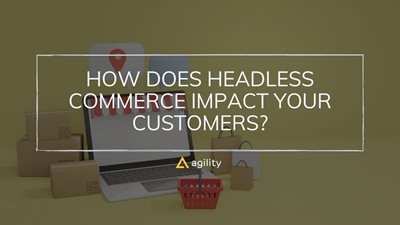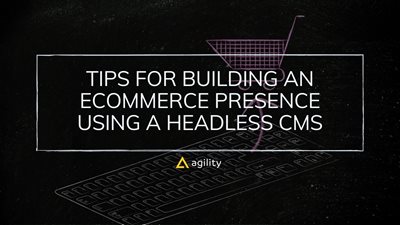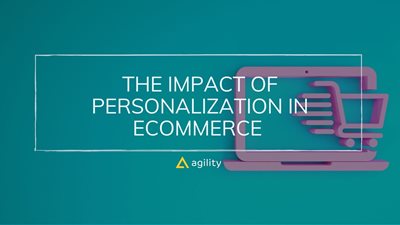How Does Headless Commerce Impact Your Customers?


Online retailers always struggle with different challenges. How do you outperform competitors? How do you satisfy visitors and convert them into customers? Many technologies entered the arena: Cloud computing, big data, artificial intelligence and more.
Headless commerce is another innovative approach to online retail. This term emerged in the context of the Internet of Things as new ways to shop for goods. Customer interactions with the brand and shopping happen outside desktop websites more and more. We can purchase smart home appliances and electronics products and comfortably switch between different solutions.
E-retailers need to ensure their websites look good on all screens and devices. How? By connecting numerous frontends to the backend. That’s what headless commerce is about (further on that later). This article will discuss a headless commerce system definition, its difference from monolithic architecture, and how it enhances the user experience.
How To Understand Headless Commerce
What the Frontend and the Backend Mean
Headless commerce relies on the way of interaction between the frontend and backend. Do you understand what these terms entail? Let’s define them before moving on to the headless overview and the monolithic vs. headless comparison.

Backend Overview
The backend consists of several databases and eCommerce tools to return the desired content to the user. Every online shopping platform backend includes product photos, customer data, prices, orders, etc.
It supports the website operation by processing, storing, and sending data to and from the side that interacts with customers (frontend). What elements perform these functions? Here are a few examples of backend constituents that ensure the frontend interactivity:
- webserver;
- application server;
- database.
They work together so that customers can study products, make orders, and manage purchases from their devices.
Frontend Overview
Frontend deals with presenting content to users. The client-side appears before visitors’ eyes after opening a website or app. Customers interact with this website part directly. They click on frontend elements to engage with backend functionalities, such as:
- exploring the product catalogue;
- adding items to their wish lists or shopping carts;
- signing up on the website.
It includes images, fonts, sliders, colours, buttons, menus, search bars, navigation, product pages, wishes list icons, a shopping cart, etc. Frontend differs depending on the devices, including computers, smartphones, self-service kiosks, voice assistants, etc.
The front-end development aims at a seamless user experience on all these screens. The ultimate goal is to create functional, handy, and aesthetically pleasing websites. For this purpose, frontend developers employ programming languages like JavaScript, HTML, and CSS as tools for building and administering a website’s frontend.
How Headless Commerce Differs from Monolithic Websites
An Overview of Monolithic Websites
Let’s turn to history. With the emergence of online stores and the Internet, all websites were displayed from desktop computers. There were no other channels. That’s why online store owners launched their websites without thinking about how they will look on smaller screens. These stores were monolithic. They are the most common solutions up to now.
How do monolithic websites work? Prospects open the store for the first time. The browser addresses the backend and receives a generated HTML file. After clicking another website link, the backend produces the HTML file from the ground up. This concept is server-side rendering.
It happens each time users browse the website. Even though there are many unchanged components, the browser has to parse everything as if for the first time. It slows down website loading, making people wait for the content to appear.
The frontend and backend are tightly coupled, limiting the system’s flexibility. For example, it complicates adding functionality. A new pop-up or another widget may slow down the website speed, cause JavaScript and CSS conflicts, or lead to vulnerabilities.
The Logic Behind Headless Commerce
That’s where the headless approach comes into play. It’s a new architecture with frontend and backend separated from each other. They utilize application programming languages (APIs) for communication. For instance, GraphQL, REST, SOAP, etc. API is a code with commands to evoke the needed action on the front or backend. It transmits data from the client to the server and vice versa.
Compared to monolithic websites, headless commerce ensures faster-loading speed. How? The backend has to generate the HTML document only for the first time opening the website. After that, the frontend, written in JavaScript, makes requests via APIs. It needs only the changed content, with static files remaining consistent. It reduces the need to build such content as header and footer every time people click other website links.
Headless commerce ensures a smooth transition between channels. As a result, the store provides an unparalleled user experience, getting the upper hand over the competition. Even if visitors don’t access websites from IoT objects, upgrading mobile UI/UX is another headless benefit.
Being headless enables you relatively easy to modify the website to suit your needs, such as introducing new features or optimizing the store. It becomes possible since you have to rebuild the frontend with cutting-edge frameworks like AngularJS or ReactJS. This move leads to adaptable online stores with an instant page load and almost endless customization.
That’s because the unchained frontend and backend don’t influence one another. So if there are some issues, they will remain in one part without having to fix bugs on both sides. Plus, developers no longer have to make changes on the frontend and backend during development.
Here we should also mention the headless backend. Monolithic is the most common approach to organizing your data on the server. However, the backend can also fall under several modules called microservices instead of having everything (catalogue, search, cart, wishlist, etc.) interconnected.
Microservices can exist independently and have several databases. It lets you tweak these blocks as you wish. You can be sure of the stability of other parts if something breaks.
Headless: Is It Applicable to Online Stores Alone?
A short answer to this question is, “No, it’s not.” Headless covers every industry, providing a distinctive user experience. It doesn’t matter what sphere you represent. You may be an online retailer, a game developer, or a travel agency owner representing a financial institution or a medical center. Opting for a headless system lets you create a more personalized and unique customer experience.
However, things aren’t so simple with headless commerce. You shouldn’t opt for this approach merely for its popularity or potential. Suppose you have a monolithic website and are satisfied with its performance and functionality.
In this case, going headless may not be the best option. You’ll need to be prepared to invest much time and effort into restructuring the store. What’s the point of rebuilding what works well now?
A different story is if you plan to scale the business. Let’s say you face issues introducing new features or changing a storefront theme. Or you want a faster website, an enhanced user experience, and a mobile-friendly solution. Headless should be your weapon of choice if you need a highly customizable website and can afford to invest money into it.
Three Benefits of Headless Commerce for Companies
Going headless can be effective if you have an online store. It will assist in preparing your website for the future in many ways, namely:
- integrating numerous touchpoints;
- outpacing your competitors with quicker development and content distribution;
- offering visitors a personalized experience;
- increasing the likelihood that they will convert.
1. Speedier Product Launch
Introducing new features is a time-consuming process on traditional websites. They also require minutes or even hours to update to reflect new content. Headless speeds up changes and improvements.
It offers flexibility and enables communication with CMS and other experience-led commerce platforms. The content resides on the central headless commerce platform. And APIs deliver it anywhere regardless of the frontend.
Such an approach positively impacts customers with the ability to experience a brand’s new solutions in the blink of an eye. You’re more likely to provide a better customer experience as content appears faster on users’ screens. It also helps retailers leave their rivals behind.
Headless commerce lets you constantly change your marketing strategies in response to new market possibilities, trends, or initiatives. It’s especially beneficial if you want to become a multi-brand company. It’s possible due to the ability to develop new APIs, programs, or systems and connect them to the store faster and easier. Additionally, building new product lines and syncing with marketing automation tools are simpler.
2. The Ability to Build a Progressive Web Application
One of the main reasons to migrate to headless commerce is to plug in new channels. But what if you just need excellent performance on desktop and mobile devices? Headless commerce may also help with this. By rewriting the frontend in the modern frameworks and making the backend return data via APIs, you transform the website into a single-page application (SPA).
SPAs are the first step to mobile-friendliness. You can make the store a progressive web app (PWA). It’s a solution that’s hard to distinguish from a native app in terms of UI/UX and lightning loading speed. But it’s a website, so you can find it by searching and installing a shortcut on the home screen.
That’s where the first benefit of PWAs comes in. As they are websites, they require storage for cache alone. Here we speak about kilobytes. You don’t have to encourage shoppers to install the native app with a weight of dozens or hundreds of megabytes.
PWAs allow you to enhance the store. And due to their discoverability by search crawlers, you can improve the website’s position in search results. Plus, PWAs are similar to native apps in the ability to send push notifications. They’re excellent tools for keeping in touch with prospects and converting them into customers.
3. Scalability to Reach New Markets
Another headless commerce benefit for online merchants is the ability to expand your business to new regions. One of the main aspects is enhanced geolocation methods and localization. How?
A headless commerce system allows companies to adapt their messaging about goods or services to the target market in various areas. Thanks to this architecture, it is easier and faster to integrate new frontends and additional software for different purposes. The capabilities go beyond translating the content into the needed language. They entail customizing the buying experience according to multiple nations, regions, cultures, and demographics, such as:
- pricing items in local currencies;
- choosing appropriate words and images to avoid offensive content;
- displaying relevant shipping variants;
- to name a few.
Headless commerce systems can display different frontends depending on where visitors come from. Like usual, store owners can manage a single backend, such as inventory and orders. Customers, in turn, enjoy an enhanced experience and are more likely to buy.
Headless Commerce and How It Affects Clients
1. Receiving Personalized Content
People are increasingly expecting personalization across numerous channels. Personalization raises the chances of making a purchase (for 80% of consumers) and influences loyalty (for 70% of consumers, according to the same data).
The predetermined UX components of legacy platforms leave much desired in 2022. Even though such stores are frequently UX optimized, rigid interface layouts, forms, and banner templates don’t provide leverage for personalization. They usually support one or two communication channels, such as websites and mobile apps. Other platforms may contain errors with displaying content and the needed features, limiting personalization capabilities for online merchants.
Headless systems are free from these limitations. They give developers complete control over UX design and management. You can develop various layouts on the frontend, add up/cross-selling blocks, and implement AI-powered solutions to deliver the most relevant offers to your prospects.
Why is headless commerce so adaptive? The reason lies in its architecture. It’s geared to numerous integrations and updates to implement without affecting the backend or causing chaos.
2. Faster Website Loading
Website speed is crucial for improving the customer experience. It’s the first thing visitors can evaluate on your resource, even before something appears before their eyes.
Slow website loading harms SEO, lowering the website ranking. Why? Because Google enumerates website speed among its ranking factors. As it’s the top search engine in the world, you seriously reduce website traffic by neglecting this factor. And lost traffic equals myriads of potential sales.
That’s why you need to constantly optimize the store for it to emerge on the screens fast. For example, reduce the image size, work on the code, and enable browser caching. Another way is to change the type of rendering on your website. That’s what headless commerce offers to its adopters.
The essence of headless commerce is transferring rendering to the client side. What does this type of rendering entail? In short, the browser saves the page structure after opening it for the first time. When you click on other website links, pages will preserve the cached layout. APIs address servers only to transmit the changed content or data. Client-side rendering boosts website loading as the server experiences less CPU usage.
3. Omnichannel Experience
The customer journey is getting more complicated all the time. We can spot an ad in search and proceed to the website. We may interact with the brand on social media or purchase offline. According to a Salesforce report, 74% of customers use more than one channel at the beginning or the end of a purchase. 76% prefer different media, such as email, phone, in-person engagement, and others.
Headless and omnichannel complement each other perfectly. Headless commerce offers online and offline purchasing experiences. So shoppers can order goods from voice assistants, a Buy button, a PWA, or another solution without having to support the frontend on the backend. Any sales interaction turns into a unified experience controlled by a single backend.
Final Word
What should an online store provide to be successful in 2022? It’s omnichannel shopping, personalization, and mobile friendliness. These are the three indispensable parts of a prosperous eCommerce business, which you should add to your must-have list. Headless commerce unites these capabilities under one umbrella.
This architecture remains a promising solution for rapidly evolving businesses with all its advantages. It allows companies to keep up with the highest standards of an impeccable shopping experience.
Headless commerce relies on modern frameworks and languages. It turns any website into a powerful selling point. So why not migrate to headless commerce now to be the first among competitors in your field?

About the Author
Alex Husar, chief technology officer at Onilab. For over eight years he’s been working on Magento migration and development projects as well as building progressive web apps (PWAs). Alex is an expert in full-stack development who shares his expertise and in-depth knowledge of modern technologies and Computer Software Engineering.
View Related Resources

Tips for Building an Ecommerce Presence Using a Headless CMS

The Impact of Personalization in Ecommerce
Agility CMS + Best In Class Ecommerce helps you increase your sales
Build the best ecommerce experience for your customers and increase your sales by delivering relevant, localized, personalized content using Agility with the leading ecommerce platforms.
Learn More

